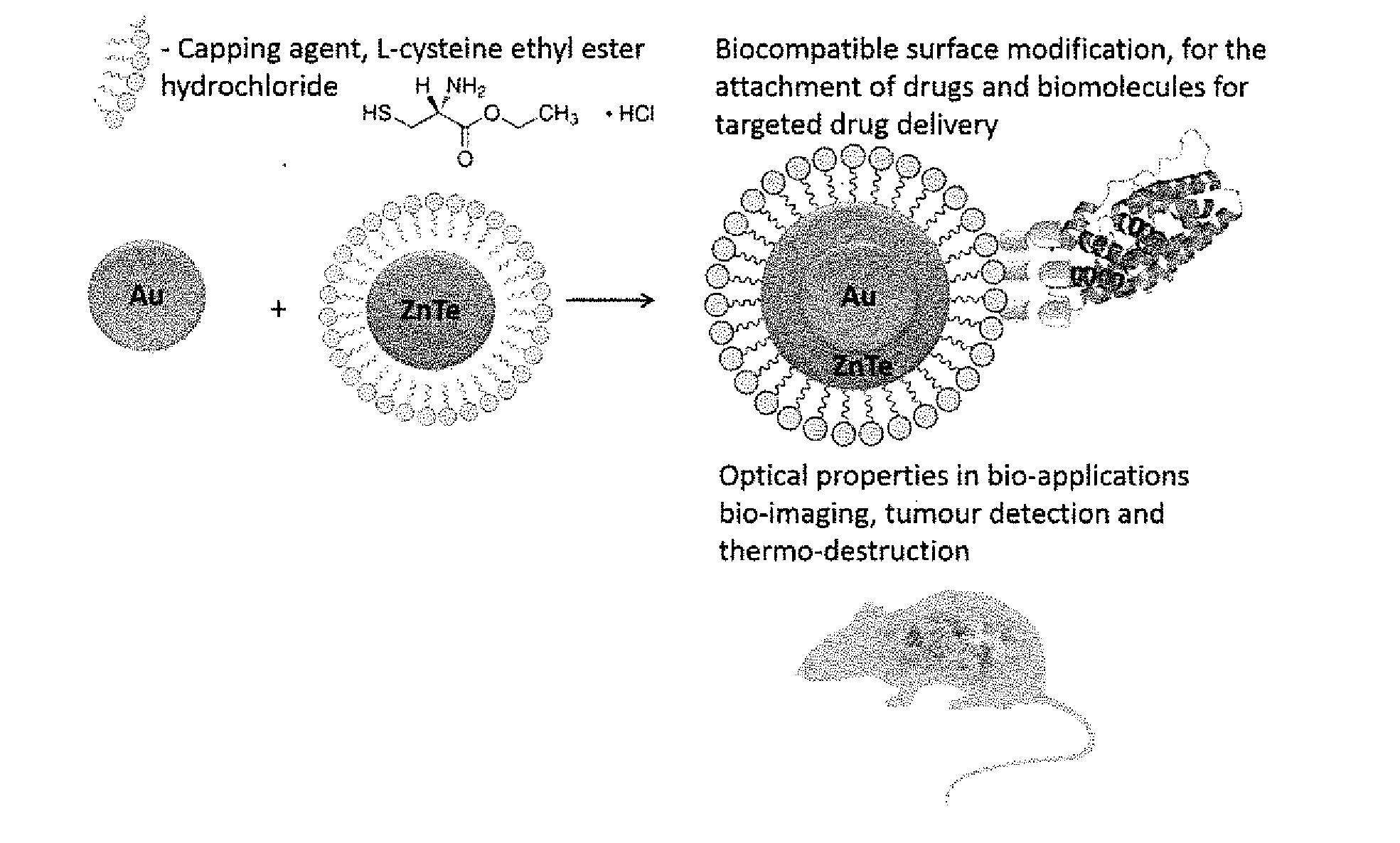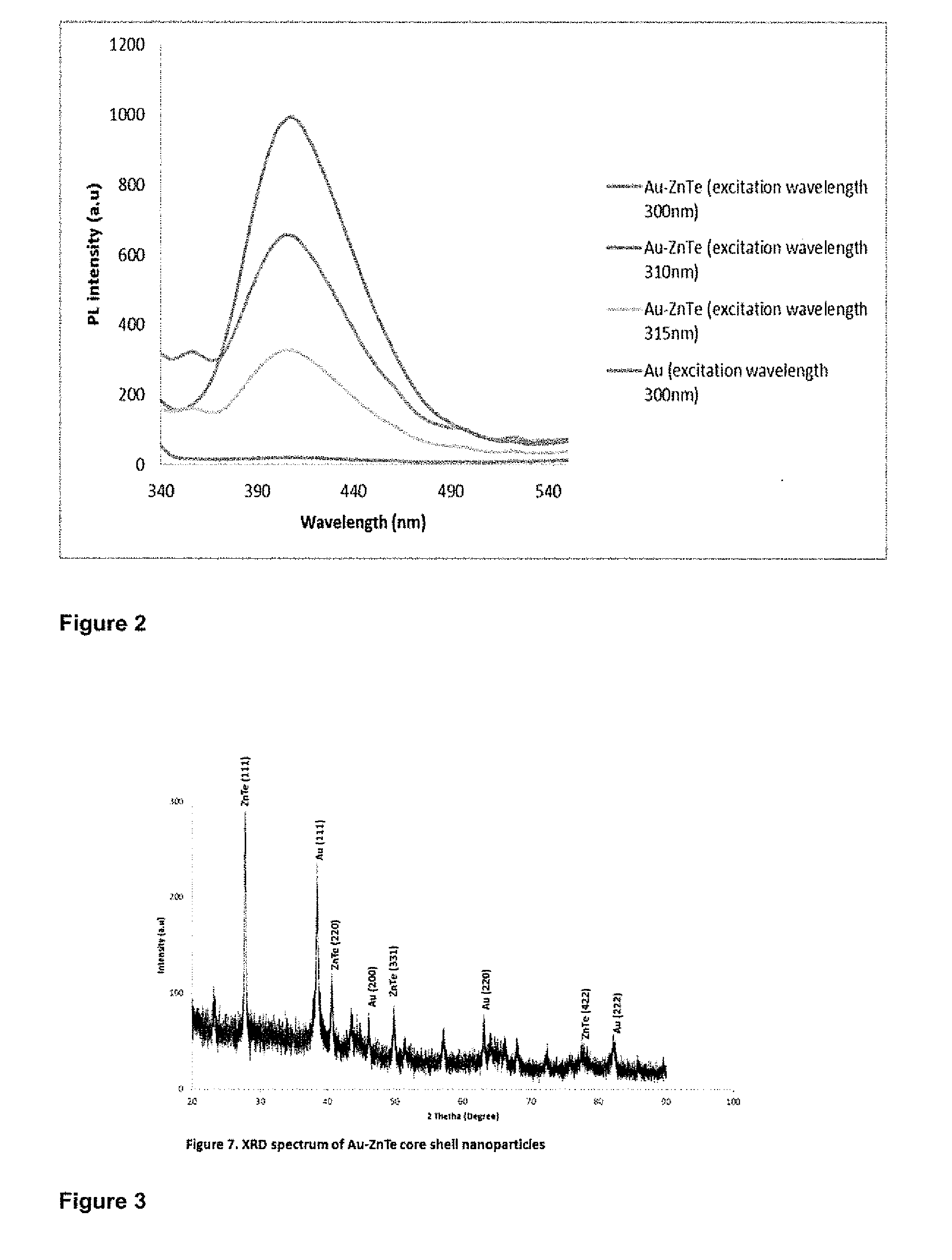The synthesis of core-shell metal-semiconductor nanomaterials
a technology of metalsemiconductor and nanomaterials, which is applied in the direction of conductive materials, powder delivery, granular delivery, etc., can solve the problems of loss of quantum yield on surface functionalization, inability to use surface functionalized nanoparticles in such applications, and inability to achieve simple bioconjugation of gold nanoparticles. to achieve the effect of carefully controlling the conductive properties
- Summary
- Abstract
- Description
- Claims
- Application Information
AI Technical Summary
Benefits of technology
Problems solved by technology
Method used
Image
Examples
example 1
Synthesis of Cysteine Capped Gold-Zinc Telluride Core / Shell Nanoparticles
[0095]An improved route to the synthesis of cysteine capped gold-zinc telluride core / shell nanoparticles is proposed. This route involves the addition of reduced gold salts to a solution of prepared cysteine capped zinc telluride quantum dots, so as to produce a dark greenish black solution of cysteine capped gold-zinc telluride core / shell nanoparticles.
[0096]In flask 1: Gold salts are reduced in the presence of citrate ions; and
[0097]In flask 2: Tellurium is reduced by sodium borohydride at room temperature under inert conditions.
[0098]The reaction is as follows:
[0099]After two hours zinc chloride (zinc salt) and L-cysteine ethyl ester hydrochloride (capping agent) solutions in a 1:10 ratio are added to the pink tellurium ion solution.
[0100]The reaction is as follows;
[0101]The reaction continued for 30 minutes at room temperature. The pH is adjusted to 7 and the temperature is increased to 60° C. After 3 hours...
example 2
Interaction of Cysteine Capped Au—ZnTe Core / Shell Nanoparticles with Cancer Cell Lines
[0106]After the core / shell nanoparticles were successfully synthesized and characterized according to Example 1, they were exposed to cancer cell lines from different target organs to establish toxicity.
[0107]Pancreas, prostate, colon and breast cancer cell lines were exposed to different concentrations of Au—ZnTe core / shell nanoparticles and the cell viability was established. The results showed that the core / shells had no toxic effect on the growth of these cell lines. To confirm this result, cell lines from two target sites (pancreas and breast cancer) that are biochemically and morphologically different were resin embedded and micro-sectioned. The results showed that Au—ZnTe core / shell nanoparticles interact with the cytoplasmic membrane and then enter the cell through phagocytosis were they are isolated in vacuoles within the cytoplasm.
[0108]The results are illustrated in FIGS. 5 to 12.
example 3
Synthesis of Au—ZnTe Core / Shell Nanoparticles
Materials
[0109]Zinc chloride, L-cysteine ethyl ester hydrochloride, gold salt, tellurium powder, sodium borohydride, sodium citrate and deionised water (HPLC grade) and acetone were obtained from Sigma Aldrich. All the chemicals were of analytical grade and used as purchased.
Synthesis of Cysteine Capped ZnTe Nanoparticles
[0110]Tellurium powder (0.32 mmol) was mixed with 20 mL of deionized water in a three necked round bottom at room temperature. Sodium borohydride (0.81 mmol) was added to the reaction mixture under inert conditions. After 2 hours 20 mL of 3.2×10−4 M ZnCl2 (zinc salt) and L-cysteine ethyl ester hydrochloride (capping agent) was added to the reaction mixture in molar ratios of 1:10. The reaction mixture was then heated at 60° C. for 3 hours under nitrogen gas. The cysteine capped ZnTe nanoparticles were separated from the mixture by filtration techniques and the sample was then concentrated by rotary evaporation, followed b...
PUM
| Property | Measurement | Unit |
|---|---|---|
| diameter | aaaaa | aaaaa |
| diameter | aaaaa | aaaaa |
| diameter | aaaaa | aaaaa |
Abstract
Description
Claims
Application Information
 Login to View More
Login to View More - R&D
- Intellectual Property
- Life Sciences
- Materials
- Tech Scout
- Unparalleled Data Quality
- Higher Quality Content
- 60% Fewer Hallucinations
Browse by: Latest US Patents, China's latest patents, Technical Efficacy Thesaurus, Application Domain, Technology Topic, Popular Technical Reports.
© 2025 PatSnap. All rights reserved.Legal|Privacy policy|Modern Slavery Act Transparency Statement|Sitemap|About US| Contact US: help@patsnap.com



